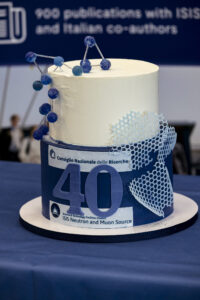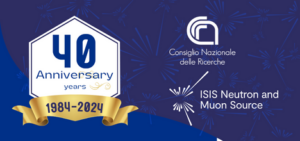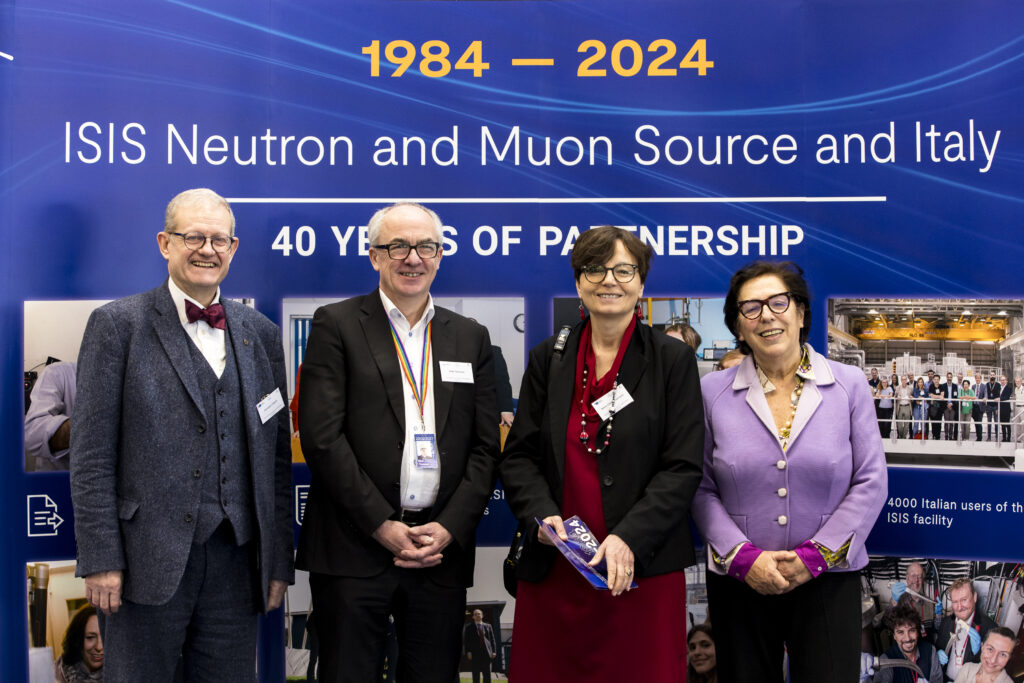
 Thursday, 15th February 2024
Thursday, 15th February 2024
Visitor Centre, Rutherford Appleton Laboratory, UK
Agenda:
11:00 – Arrival and refreshments
11:30 – Welcome – Maria Chiara Carrozza, Mark Thomson
12:00 – ISIS: Endeavour and beyond – Roger Eccleston
12:15 – Partnership overview – Carla Andreani, Andrew Taylor
12:30 – Lunch
13:30 – Partnership successes
13:30 – Cultural heritage studies – Antonella Scherillo
13:45 – Molecular spectroscopy developments – Vicky Garcia-Sakai
14:00 – Muon spectroscopy – Roberto de Renzi
14:15 – Instrumentation developments – Roberto Senesi
14:30 – In-kind developments – Giuseppe Gorini
15:00 – Cake cutting and photos
15:45 – Tours of ISIS
For a timeline of the ISIS-Italy partnership, see this link: ISIS-Italy Brochure
One of the most significant international partnerships at ISIS Neutron and Muon Source, the relationship with Italy dates back to 1984. Enabling both Italian and UK researchers to pool knowledge and experience with collaborators across the UK and Italy, this joint venture recognises the value neutron and muon probes bring to multidisciplinary research. With over 4000 Italian researchers using ISIS in a variety of research areas and producing upwards of 900 scientific publications, this collaboration has now been producing excellent science for over 40 years.
Twelve neutron or muon instruments, including INES, Vesuvio, and ChipIR have been constructed at ISIS through the ISIS-Italy collaboration. These instruments, and in-kind contributions from the Italian National Research Council (CNR) underscore the depth of this successful collaboration.
Commemorating four decades of this productive international collaboration on February 15, 2024, a special event hosted at the Rutherford Appleton Laboratory welcomed esteemed guests including Amb. Inigo Lambertini, Italy’s Ambassador to the UK, and Prof. Maria Chiara Carrozza, President of The CNR. The event also included participation from representatives of Italian universities and the user community.
The celebration event noted significant scientific achievements of the partnership, including the development of cultural heritage studies using neutron and muon beams. The strong links between the people involved in the collaboration were noted throughout the talks.
Welcome addresses were given by Prof Carrozza and STFC’s Executive Chair, Prof Mark Thomson. ISIS Director Prof Roger Eccleston gave an overview of the ISIS Neutron and Muon Source, and a summary of the partnership was outlined by Prof Carla Andreani, Executive Director of ISIS@MACH ITALIA and Full Professor at the University of Rome Tor Vergata and Prof Andrew Taylor, former ISIS Director. Further talks from Italian and ISIS researchers highlighted the instrument and science achievements of the collaboration.
The success of this fruitful international partnerships is owed to the many academics, technicians and administrators from across Italy. Seasoned academics such as Prof. Silvia Licoccia from The University of Rome Tor Vergata, director of the interdisciplinary research centre, Centro NAST, is not stranger to the complexities and opportunities presented by distributed large-scale research infrastructures. Commenting on the milestone celebration, she said “The whole ISIS@MACH ITALIA team is very proud to have contributed to widen the knowledge between Italian young researches about the extent and variety of information that it is possible to achieve by the use of neutron studies. The seeds planted by STFC and CNR during their long collaboration are blooming for the next generation of modern, interdisciplinary scientists.”
Prof. Giuseppe Gorini from the university of Milano-Bicocca, a long-term collaborator in the Italy-ISIS partnership reflected on the event, saying “Through the in-kind investment of CNR in the ISIS instrument suite we have built much more than a set of world-class tools for scientific studies. In this effort, ISIS@MACH ITALIA is building a community of users, instrument scientists and engineers that is ready to design the future of research infrastructure using a network of Medium Range Facilities operating a pipeline with Large Scale Facilities such as ISIS.”
Another emanant attendee was Prof. Roberto Senesi of the University of Rome Tor Vergata, who has been intimately involved in the construction of a number of instruments at ISIS including ChipIR, VESUVIO and IMAT. He added “ This event marks the success of creating communities across borders, and across generations of researchers. Many of us acknowledge the unique value of working at instrument construction and exploiting the science that follows, in a fantastic environment at Large Scale Facilities such as ISIS. I am optimistic about the continuing benefits of this collaboration, not only with ISIS, but other Medium and Small Range Facilities that form the ISIS@MACH ITALIA network.”
Understanding the properties of materials on the nanoscale provides the opportunity to develop advanced materials, tailoring their properties for specific applications, tackling global challenges across life, chemical, medical, physical and engineering sciences as well as in arts, heritage and archaeology. It has become evident that addressing varied problems such as green energy or antibiotic resistance, the digital economy or food security, requires a multidisciplinary approach. Academic and industry researchers from Italy and the ISIS neutron and muon source are working together and bringing expertise in areas including aerospace engineering, biomaterials, building greener economies, cultural heritage, and energy research.

Notes:
ISIS@MACH ITALIA is a broad ranging research infrastructure and a multidisciplinary project, linking research teams across Italy with small, medium and large-scale research facilities. Launched in 2020, funded by the Italian Ministry of Research (MUR), IM@IT has already serves nearly 300 active users, with participants growing every year. Under sustainable funding, we aim to develop the next generation of collaborative researchers from both academia and industry, and to be the catalyst for transforming the research ecosystem in Italy and beyond.
IM@IT is listed in the Italian Ministry of University and Research’s Piano Nazionale delle Infrastrutture di Ricerca (PNIR 2021-2027) “in the broader notion of ISIS”, and ISIS Facility and IM@IT are jointly listed in high priority RI’s (see Table 10 page 40 PNIR in 2021-2027.
The ISIS Neutron & Muon Source is a world-leading centre for research in the physical and life sciences at the STFC Rutherford Appleton Laboratory near Oxford in the UK. Its suite of 35 neutron and muon instruments gives unique insights into the properties of materials on the atomic scale. The facility supports a national and international community of more than 3000 scientists for research into subjects ranging from clean energy and the environment, pharmaceuticals and health care, through to nanotechnology and materials engineering, catalysis and polymers, and on to fundamental studies of materials.
The Italian National Research Council (CNR) is the largest public research institution in Italy, the only one under the Research Ministry performing multidisciplinary activities. Founded as legal person on 18 November 1923, CNR’s mission is to perform research in its own Institutes, to promote innovation and competitiveness of the national industrial system, to promote the internationalization of the national research system, to provide technologies and solutions to emerging public and private needs, to advice Government and other public bodies, and to contribute to the qualification of human resources.
Shibl Gill
